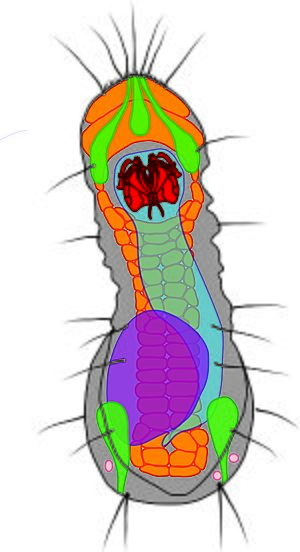Limnognathia facts for kids
Quick facts for kids Limnognathia |
|
|---|---|
 |
|
| Schematic drawing of Limnognathia maerski | |
| Scientific classification | |
| Genus: |
Limnognathia
|
| Species: |
maerski
|
Limnognathia maerski is a tiny, tiny animal, so small you need a microscope to see it! It's one of the smallest animals known, usually only about one-tenth of a millimeter long. That's like the thickness of a few hairs!
This amazing creature was first found in 1994 in warm springs on Disko Island, which is in Greenland. Scientists are still learning about where it fits in the big family tree of animals, called taxonomy.
Limnognathia maerski is part of a group called Gnathifera. This group also includes other tiny animals like rotifers and gnathostomulida.
Contents
What Does It Look Like?
L. maerski might be tiny, but it has some really cool features!
Amazing Jaws
This little animal has very complex jaws. They are made of fifteen separate parts! These tiny jaw pieces are connected by stretchy parts called ligaments and tiny muscles. The jaw parts are super small, from 4 to 14 micrometers. A micrometer is one-millionth of a meter!
When L. maerski eats, it can push part of its jaw outside its mouth. It also pushes out its jaw when it needs to spit out things it can't digest.
Brain and Body
L. maerski has a large 'brain' in its head. This brain is called a ganglion. From its brain, two nerve cords run down the underside of its body all the way to its tail.
Its body also has stiff, sensory bristles. These bristles are made of one to three tiny hairs called cilia. They are spread out over its body and help it sense its surroundings.
Moving Around
L. maerski also has flexible cilia that help it move and eat.
- Some cilia are on its forehead in a horseshoe shape. These create a current in the water. This current helps to pull food particles towards its mouth.
- Other cilia are on the sides of its head and in two rows on the underside of its body. These cilia work like tiny oars to help the animal swim and move around.
Life Cycle and Reproduction
All the L. maerski specimens that scientists have found so far have had female organs. This means they can lay eggs.
They lay two different kinds of eggs:
- Thin-walled eggs: These eggs hatch very quickly.
- Thick-walled eggs: Scientists believe these eggs are tough and can survive freezing temperatures. This means they can stay safe through the winter and hatch when spring comes.
This pattern of eggs is also seen in rotifers, which are related to L. maerski. In rotifers, thick-walled eggs only form after a male fertilizes them. Scientists now think that L. maerski might hatch as males and then change into females as they grow older. This is a very interesting way to reproduce!

